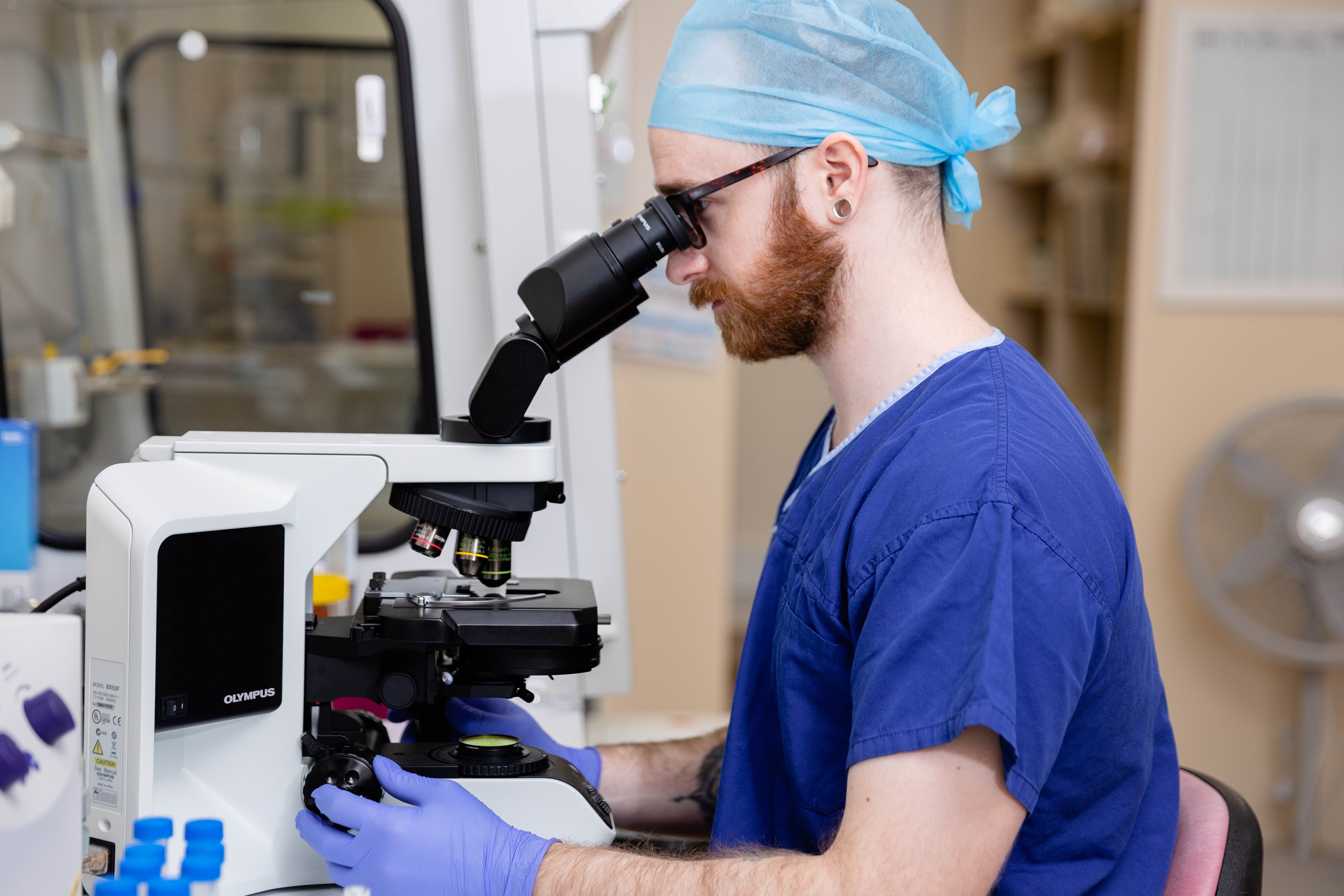
Health & Medicine
Women and the slowing global population

A global team of experts has made ten crucial recommendations to urgently tackle the worldwide decline in male fertility
Published 13 October 2023
It’s now estimated that infertility affects one in every six couples of reproductive age around the world. There are multiple complex reasons why people experience infertility, almost certainly involving a mix of biological changes, environmental and lifestyle exposures and social pressures.
However, one common misconception is that the inability to conceive a baby is usually due to female infertility.

In fact, infertility is comparable in men and women until middle age, after which female fertility declines more rapidly. And this is not to say that age does not affect male fertility.
There is evidence that male reproductive health may have declined over recent decades. This includes decreasing semen quality, increasing frequency of testicular cancer and congenital defects in the male urogenital system.
The European Society for Human Reproduction and Embryology recently commissioned a group of 26 international experts (including the authors of this article) to identify key gaps in our understanding and other barriers and opportunities for researchers, governments, healthcare systems and public education to improve men’s reproductive health.

Health & Medicine
Women and the slowing global population
Importantly, we considered the benefits of understanding male infertility to broader society.
Nature Reviews Urology has just published our report, Frequency, morbidity and equity – the case for increased research on male fertility highlighting the need for urgent, global action.
Declining male fertility is like a ‘canary in a coal mine’ signalling a worldwide decline in male health and consequent increase in socioeconomic burdens for everyone.

Emerging data suggests that male infertility is often a biomarker for other serious health problems, including cancer and metabolic diseases.
Compared to fertile men, infertile men appear to experience a higher rate of a range of chronic health disorders and even a shortened lifespan.
For couples wanting children, male infertility can cause intense psychological suffering and treatment attempts are expensive.

Health & Medicine
The household chemicals affecting your fertility
The cost to broader society of the financial, personal and relationship stress and lost productivity stemming from infertility is underappreciated.
Beyond the individual couple, in regions where birth rates have fallen below the population replacement level (in developed countries, an average of 2.1 children per woman), infertility may be contributing to concerning changes in social structures.
Without replacement births, as the population ages, the workforce and economy will shrink, tax revenue will drop and government-funded services will become unsustainable.
Several developed countries are already facing this complex problem – a result of social attitudes, economic forces, sex ratios, mortality rates and migration policies, as well as infertility.

Male infertility is defined as the inability to make a fertile female pregnant, after a year of frequent, unprotected sexual intercourse. Clinical designation of a man as ‘infertile’ may be based on his family history, physical examination, hormone profiles and/or semen analyses.
Frustratingly, for most infertile men, the precise cause of their infertility cannot be determined. Rather, patients are categorised by their symptoms.

Business & Economics
Thinking about using donated eggs to start a family?
The inability to find a reason is a consequence of long-term, inadequate funding for male infertility research that has constrained the development of targeted treatments.
By the time they seek medical advice, men experiencing infertility are often in emotional distress, made worse when doctors are unable to offer any explanation or treatment.
Infertile men and their partners deserve more support. We want men to feel comfortable talking about their fertility with their healthcare professional as early intervention will help.
Our knowledge gaps also exacerbate gender inequality in medical treatment.
We know that men want to play a stronger role in conception strategies. However, the default response to male infertility is medically assisted reproduction, involving in vitro fertilisation using the most mature sperm cells available.

While these technologies have enriched the lives of many Australians, their use in cases of male infertility fails to address the underlying cause and pushes the burdensome and invasive procedures and associated risks onto women.
On the flip side, our poor understanding of the processes of male fertility and reproductive health inhibits the development of male-based contraceptive methods – which many men and women want.
To fill these knowledge gaps, there is a desperate need to establish multi-centre biobanks containing biological material and high-quality clinical data, which will enable the determination of genetic, lifestyle and environmental factors in infertility and other health issues.

Health & Medicine
Confessions of a professional baby maker
A commonly held belief is that a man can ‘clean up his act’ just before attempting to conceive a child – for example, quitting recreational drugs – and his fertility will bounce back to a healthy level.
However, evidence is mounting that male fertility can be permanently reduced by genetic, lifestyle and environmental factors from the beginning of life – through boyhood, adolescence and beyond.
Genetic factors that reduce male fertility range from abnormalities at the chromosomal level – like Klinefelter syndrome, when a boy is born with an extra X chromosome in every cell – to subtle mutations in single genes.

Genetic screening to diagnose male infertility is extremely limited because it is not covered by public health care or insurance and research into genetic causes of male infertility has not been funded to the same extent as other medical conditions.
On its own, male infertility, like other diseases, is worthy of diagnosis and treatment.
Since male infertility can flag other diseases, the lack of diagnoses and treatments means we are missing opportunities to improve men’s health on multiple levels.

Politics & Society
Boy or girl: Should we be able to choose?
Lifestyle factors impact male fertility across their lifespan. These include smoking, drinking excessive alcohol, being overweight or using androgenic steroids.
Environmental factors include endocrine-disrupting chemicals found in many products including plastics and pesticides, which reduce fertility by affecting hormone concentrations and functions.
Our understanding of male fertility risks and their severity is incomplete and studies of risk factors in the combinations experienced in real life are rare.
If the full impact of risky behaviours or exposures were known – men and society may choose to minimise them.
Reflecting global concern about male infertility, the expert working group behind our report comes from Argentina, Australia, Canada, China, Denmark, Germany, Italy, Spain, the United Kingdom and the United States.

Underlining the need for interdisciplinary collaboration to find solutions, our group included leaders in andrology, gynaecology, urology, cellular biology, endocrinology, environmental hazards, pathology, reproductive medicine, medically assisted reproduction, oncology, genetics, paediatrics, pharmacology and therapeutics.
Following a comprehensive literature review, we reached a consensus on ten recommendations for positive change and collaboration in research, policy, practice and education to improve male reproductive health.

Health & Medicine
The ethics of a child’s future fertility
1. Governments, health care systems, insurance companies and the public should understand and acknowledge that male infertility is a common, serious medical condition and patients have a right to meaningful diagnoses and targeted treatments.
2. Establish a global network of registries and biobanks containing standardised clinical and lifestyle information, and tissue from fertile and infertile men, their partners and children. Link them to national healthcare data systems.
3. Implement protocols and incentives to standardise collection of de-identified tissue and clinical/lifestyle data.
4. Fund and undertake more international multi-centred, collaborative research to understand the interactions and impacts of genetic, lifestyle and environmental factors on male fertility in diverse populations.

5. Integrate genomic sequencing into the diagnosis of male infertility.
6. Develop additional diagnostic tests to improve diagnosis and add predictive power for male infertility protocols.
7. Rigorously evaluate the impact on male fertility of compounds – including endocrine-disrupting chemicals – in products, the workplace and the environment. Implement regulations and policies and develop safe alternatives.

Sciences & Technology
‘Safe’ herbicide in Australian water affects male fertility
8. Rigorously evaluate strategies for medically assisted reproduction before integrating them into clinical practice.
9. Run public education campaigns to promote discussion of male infertility and engagement in health-seeking.
10. Improve training for healthcare workers to promote male reproductive health across the lifespan.
Male infertility is a serious disease and an increasing problem for everyone. We urge governments and health systems around the world to implement these recommendations swiftly.
Banner: Getty Images